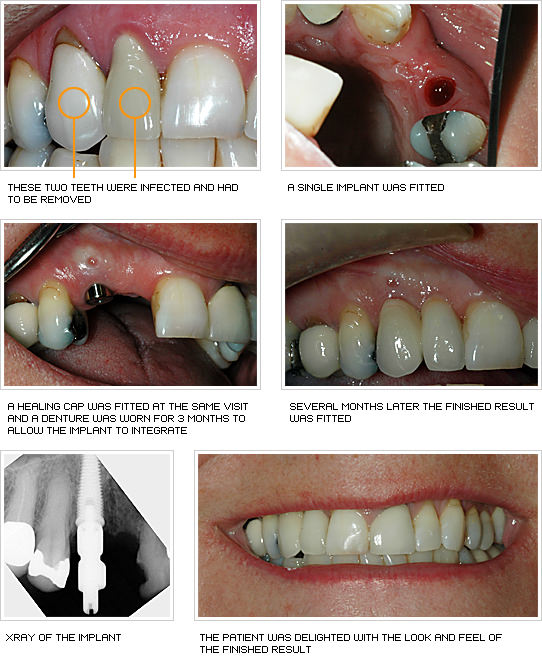7 Simple Techniques For Dental Sense
7 Simple Techniques For Dental Sense
Blog Article
The Buzz on Dental Sense
Table of ContentsThe Dental Sense IdeasThe smart Trick of Dental Sense That Nobody is DiscussingSome Of Dental SenseFascination About Dental Sense
are medical devices operatively dental implanted into the jaw to restore a person's capability to chew or their look. They give support for synthetic (phony) teeth, such as crowns, bridges, or dentures. When a tooth is lost because of injury or illness, a person can experience complications such as fast bone loss, defective speech, or changes to chewing patterns that result in discomfort.Dental implant systems consist of a dental implant body and oral implant abutment and may also consist of an abutment fixation screw. Kids dental. The dental implant body is surgically inserted in the jawbone in area of the tooth's root. The dental implant joint is normally affixed to the dental implant body by the joint fixation screw and prolongs via periodontals into the mouth to sustain the affixed man-made teeth
(https://pxhere.com/en/photographer-me/4492670)Framework of The Oral Implant System choosing dental implants, talk with your oral service provider concerning the prospective benefits and risks, and whether you are a prospect for the procedure. Points to take into consideration: Your overall health and wellness is a vital consider identifying whether you are a great prospect for dental implants, the length of time it will take to recover, and for how long the implant might remain in area.
Smoking cigarettes may affect the recovery procedure and reduce the long-lasting success of the implant. The recovery procedure for the implant body may take a number of months or longer, during which time you generally have a temporary joint instead of the tooth. the dental implant procedure: Thoroughly follow the dental hygiene instructions offered to you by your dental provider.
Not known Incorrect Statements About Dental Sense
Implant failure can cause the requirement for another procedure to deal with or replace the dental implant system. Brings back the capability to eat Brings back aesthetic appearance Assists keep the jawbone from shrinking due to bone loss Preserves the health and wellness of the surrounding bone and gums Aids maintain surrounding (nearby) teeth secure Improves lifestyle Damages to surrounding all-natural teeth throughout implant positioning Injury to the surrounding cells during surgical procedure, such as sinus perforation Injury during surgical procedure (for example, fracture of bordering jawbone) Insufficient function, such as seeming like the teeth do not bite with each other usually An experience that the tooth hangs or twisting in position resulting from an abutment screw loosening up Implant body failing (looseness of the dental implant body) because of systemic infection, which might be more likely in clients with unchecked diabetes mellitus because of local infection in bone and gum tissues supporting the dental implant body due to postponed healing, which may be most likely in patients who smoke Problem cleaning the gums around the implant, resulting in bad oral health Neglected gum condition Post-surgical pins and needles because of nerve impingement or damage Constantly alert healthcare suppliers and imaging specialists that you have dental implants before any type of magnetic resonance imaging (MRI) or x-ray procedures.
FDA is not conscious of any negative occasions reported for MRI or x-ray treatments with dental implants. Oral implants systems are normally constructed from materials that follow global agreement criteria of the International Company for Standardization (ISO) or ASTM International. These requirements have details of what makes a secure material.

A dental implant is a structure that changes a missing out on tooth. With screw-like tools, the specialist inserts a dental implant right into the jawbone, and it functions as a support for a synthetic tooth, called a crown. A tool called a joint attaches the artificial tooth to the dental implant. The crown is personalized to fit the person's mouth and match the color of their teeth.
Getting My Dental Sense To Work
Some individuals are not eligible for oral implant surgery. It is for dental surgeons to operate people with: intense illnessuncontrollable metabolic diseasebone or soft tissue illness or infectionIf these concerns are solved, a person can have the surgical procedure. In, oral surgeons abstain from operating individuals with: If people with any one of the above go through dental implant surgery, there is a higher risk of the dental implant failing.

Dental dental implant surgery is an individualized procedure. Give you time to recover. Affix the post and final crown, bridge or denture.
Next, your surgeon will carefully place the dental implant into your jaw. Your doctor will rearrange your gum tissues and shut the incision with stitches. If your dental implant is near the front of your mouth, your dental practitioner will make a temporary tooth for you to wear till you heal. By doing this, you won't have a gap in your smile while you recoup.
Rumored Buzz on Dental Sense
Your copyright can inform you what to expect in your circumstance. During the healing phase, your jawbone ought to fuse to the dental implant. This procedure, called osseointegration, is important for security and long-term success. This process can take anywhere from three to 9 months. In some instances, it may take much longer.
As soon as your implant heals, your dental practitioner can attach the joint (little connector blog post) and your final remediation (crown, bridge or denture). This typically takes concerning one hour to complete and may call for a 2nd minor surgery. You shouldn't really feel any kind of discomfort throughout your oral implant treatment because your supplier will utilize drug to numb your gums.
Report this page